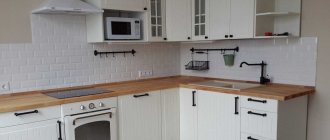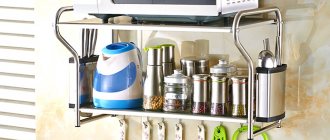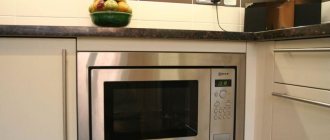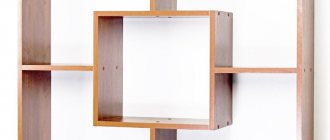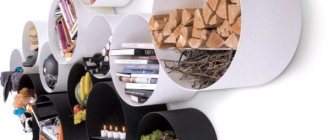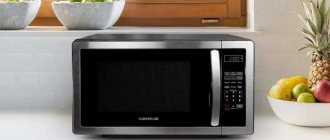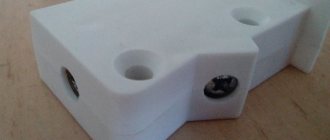A microwave oven is a necessary item in the kitchen, with which you can quickly heat up food at any time. Over many years of use, the microwave has become a common appliance in the home, but there is not always free space in the kitchen to install it.
To save space, the device is installed using special fasteners, one of which is a microwave shelf on the wall. More information about making such a shelf with your own hands will be discussed in this article.
Microwave shelf on the wall
Choosing a location to install the microwave oven bracket
When using a microwave every day, its location should be as convenient as possible. A few tips to ensure the bracket is installed correctly:
- To avoid injury, installed equipment should not interfere with movement around the kitchen.
- In order not to use additional extension cords, it is necessary to provide an outlet next to the microwave. You should think about this even before finishing the walls. Otherwise, you can lay the wiring in the cable channel.
- The door should not block other objects when opening.
- To avoid excessive contamination, choose a location away from the sink and stove.
- To prevent the microwave from overheating, it is necessary to leave free space at the top - up to 10 cm. This will ensure air access to the heating parts.
- The wall and the fastening itself must be reliable.
- If you want to fill a corner and use the space ergonomically, you can place the microwave in the corner.
- You should not hang the stove too high; the device should be accessible to all adult family members.
Where is the best place to place a microwave?
I would like all household appliances in the kitchen to be arranged compactly and conveniently for use. If the working area of the kitchen is large, then the device can be placed directly on the table. This does not require any additional fastenings or additional effort. If the kitchenette is small, then this option for placing a microwave is extremely inconvenient.
You can place the device on the refrigerator, but high temperatures may affect the body of the product. In this case, the refrigerator should be low, otherwise it will be difficult to reach the stove.
To make spending time in the kitchen enjoyable, many people place a TV in the room. It is better not to place a microwave next to it.
You cannot install the TV directly on a microwave oven:
- This will disrupt the ventilation in the space around the stove.
- The body of the device heats up, which affects the operation of the TV.
- The food is cooked at high temperatures and a lot of steam comes out when the door is opened. This has a very negative effect on the equipment that sits on the microwave.
The option looks good when the niche for the stove is built into the kitchen unit. The niche in the closet should have a significant height and size. And you need to remember that the space around the device must be well ventilated.
You can place the microwave oven under the countertop by replacing the bottom drawer. This will free up the work surface.
Placing the stove above the stove allows for efficient use of limited space, but steam and grease from the stove can damage the microwave cabinet.
Modern kitchen sets already have space for a microwave oven. In this version, there are appliances in the kitchen, but they are not noticeable.
You can purchase integrated appliances: a microwave and an oven in one housing.
If the size of the kitchen allows, the microwave can be placed on the so-called island for household appliances. The island is located in the middle of the kitchen and all electrical appliances are placed on it.
How to choose a mounting location for the bracket
To make it convenient to use a microwave oven, you need to choose the right place to install it. If such equipment is placed on the wall, experts recommend the following solutions:
- access to the device door must be free both to the control elements of the device and to the internal space of the working chamber;
- It is not recommended to place the microwave above the sink or next to the hob;
- the installation height above the floor should be such that it is convenient for all family members to use the device;
- When choosing an installation location, it is necessary to take into account the presence of a nearby plug socket through which the device will be connected to the electrical network.
FOR YOUR INFORMATION!
For each microwave oven, there are original mounting brackets designed for a specific model.
Placing the microwave on a shelf made of chipboard and metal mounting angles
Choosing a shelf mount
There are several main criteria by which you should choose a shelf design and fastening elements for it. It is necessary to take into account the technical characteristics and features of the electrical device.
Microwave shelf
Weight
As a rule, microwave ovens weigh on average 12-14 kg, but their weight increases with the food that is added inside. Therefore, when choosing fasteners, you should choose products that can withstand up to 30 kg. To avoid making a mistake with your choice, you should find out the exact weight of the shelf and microwave before purchasing.
Corner shelf for microwave
Dimensions
The sizes of microwaves can vary, so when making a wall shelf you need to take this into account. If the device will be fastened with special fasteners, which you can buy in a store or make yourself, their dimensions must also match the dimensions of the microwave oven.
Wall shelf for microwave
Ease of use
This depends on the individual preferences of the owners, because the microwave can be installed on special brackets or on a full-fledged shelf, the height, size and material of which will determine the ease of use. But if you make a shelf yourself, then you cannot skimp on material - it must be stable and reliable.
Microwave shelf
On a note! It is necessary to take into account the material of the wall in the kitchen when choosing where to install the shelf and fasteners. Since the microwave oven weighs quite a lot, installing the shelf on a decorative partition is strictly not recommended. The same can be said about finishing panels or false walls. Otherwise, the entire structure may collapse over time.
How to hang a microwave on the wall
When all the elements are in place, you can begin installation and assembly of the structure. At this stage you need to prepare the fasteners and tools necessary for installation. When installing on lightweight partitions made of wood or plasterboard, anchor bolts are used; for brick or concrete walls, expansion dowels are used. In both cases, to carry out the work you will need an electric drill or screwdriver, a construction level, a tape measure and a pencil, as well as a set of screwdrivers, a hammer and wrenches.
The bracket for the “Bravo FS01” microwave oven has a somewhat unusual design that allows you to adjust the size not only according to the length of the shelves, but also according to the distance between them
The work is performed in the following sequence:
at the selected location, markings are made according to the holes on the bracket body;
Important! When marking the mounting points of the brackets, the locations of the fastening elements on both brackets should be located in the same horizontal plane
- holes are drilled at the marked points, the diameter of which must correspond to the fastening elements;
- when installed on light partitions, the holes are drilled through, when placed in solid walls - to the depth of the expansion dowel or anchor used;
- the fastening elements used are installed - the expansion dowels are hammered in, and the anchor bolts are secured using wrenches and a fixing nut;
- Brackets are installed and fixed in a given position.
Option for installing a shelf for a microwave oven from slab lumber. When the installation of the brackets is completed, it is necessary to check the observance of the horizontal plane between the shelves of the holders, they must be located in the same horizontal plane, as well as the strength of their fastening to the wall. After this, you can begin installing the microwave oven on the mounted structure; to do this, perform the following activities:
- the shelves of the brackets extend to the desired length, and if there is movement in width, this size is also adjustable;
- the microwave is installed on the prepared structure;
- its stability and the length of the power cable are checked to connect to the plug connection.
Placing brackets above a washing machine or refrigerator is completely justified and convenient to use
Bracket construction
There is another method of mounting a microwave on the wall, which is no less effective. We are talking about special brackets. With their help, you can secure not only the microwave, but also other objects, such as televisions. You can easily buy such parts at your nearest hardware store. But if you wish, you can make the brackets yourself, although this requires experience with a welding machine.
Microwave Oven Brackets
There is nothing complicated in installing ready-made brackets - they are fixed to the wall using large self-tapping screws. It is enough to drill several holes in the right places, insert dowels and screw the structure. You can place a small shelf made of wood on top of it so that the product fits harmoniously into the interior of the kitchen. The advantages of this method of mounting a microwave include the invisibility of the brackets.
Installed microwave bracket
Photo - microwave bracket
How to make it yourself
By placing the stove on a special shelf, you can get free working surfaces and a convenient approach. Using the necessary materials and tools, you can equip this part of the interior yourself.
Required materials and tools
All tools and materials can be purchased at specialized and furniture stores.
Required:
- pencil and tape measure;
- mounting angles;
- hacksaw;
- drill and screwdriver;
- grinding machine;
- corner rounding pattern;
- carpenter's clamps;
- devices for drilling inclined surfaces;
- self-tapping screws;
- wide board or furniture boards with an edge;
- wood tinting agent;
- wood varnish;
- sandpaper;
- wood glue.
It is necessary to think about the size, shape and design of the product in advance.
Making a universal shelf
You can make the simplest option - a single-tier shelf mounted on the wall using mounting angles.
Before starting work, you need to decide exactly where to place the product, as well as prepare all the material in advance.
To work you will need:
- furniture panels with edges - three pieces;
- mounting angles - 20 x 30 cm in size;
- metal rod: diameter - 22 mm, length - 2.2 m;
- flanges (a part intended for connecting pipes) with fasteners;
- drill with attachments and screwdriver;
- hammer drill
You need to choose steel flanges - sillumin flanges will not support the weight of the microwave. The size of the product depends on the dimensions of the microwave oven.
What should be done:
- Mark the centers of the flanges with a pencil. The distance from the corners should be 3 x 3 cm.
- Drill holes in the central shelf with a diameter of 22 mm. Attach the flanges on both sides on the same plane.
- Cut the metal rod into four equal sections, the length of which is 65 mm.
- Secure the rods to the flange using clamping screws. Tighten the screws tightly.
- If the structure is single-level, it will consist of one plane. Its size should be slightly larger than the size of the stove. You need to firmly attach two mounting angles on the side where the shelf will be attached to the wall.
This option is universal. And it will not spoil the overall appearance of the kitchen space.
Rack
A small wall-mounted rack is a good option for installing and storing not only a microwave oven, but also other small household appliances, as well as various kitchen utensils. Such racks are mobile and perfect for any interior.
Even if you remove household appliances, the rack will still be useful for kitchen small items.
You need to prepare:
- three furniture boards;
- metal rods with a diameter of 22 mm;
- flanges - 16 pieces;
- metal corners measuring 200 x 300 mm;
- clamping screws.
Before you start work, you need to make a drawing and blanks.
Manufacturing process:
- Mark the places where the flanges are attached on the furniture boards. The distance from the corners is 30 mm.
- Drill four holes with a diameter of 22 mm in the middle shelf.
- Fix the flanges on the middle shelf on both sides.
- Cut 70 mm parts from the metal rod - four pieces.
- Fasten the parts to the flange with a clamping screw.
- Attach the shelves to each other.
- Install corners behind the rack for hanging on the wall.
The last step in the work will be to install the rack in a convenient location.
Shelf made of brackets
A good solution is to use bracket holders that are designed for wall mounting of a microwave oven. They come with rubber pads and plugs.
The bracket is quite easy to attach yourself. It has the maximum level of security. The base is adjustable (the length of the grip arms is adjustable up to 50 cm), which allows you to customize the design to suit any model. The bracket can support weights up to 35 kg.
Microwave shelf requirements
In modern kitchens, it is quite difficult to find a place for a microwave: you need a strong base, good ventilation, and space for the door to open freely. It is necessary to ensure a safe distance from the stove, sink, and heating radiator. You cannot place a teapot or coffee maker on the appliance. The optimal distance from the floor is about 85 cm. The socket should be no further than one and a half meters.
To ensure good ventilation for the appliance, do not cover it with napkins or towels. The space behind the back wall of the microwave oven should be at least 10 cm, above the top cover - about 20 cm, around the side walls - 5 cm.
It is good to place household appliances on the desktop: when the device is installed no higher than chest level, it is easier to get hot dishes.
Sometimes the stove is placed on the windowsill. It must have sufficient width
It is important to remember that the elements of the device get very hot - in winter this can lead to cracks in the glass
You can place the microwave oven in a kitchen cabinet, providing ventilation holes in advance.
The best location for a microwave is a special shelf mounted on the wall.
You can simply purchase a shelf for the TV and install a microwave oven on it. But in this case, you won’t be able to do anything under the device—it’s unsafe.
The kitchen should be comfortable and safe. The microwave oven must be placed so that it is convenient to use.
In order to attach the product to the wall, you must follow certain requirements:
- There must be good ventilation. If the shelf covers the device from the top and sides, you need to drill holes for ventilation.
- The dimensions of the structure should not create inconvenience in the kitchen.
- The product must be made of durable material to support the weight of the microwave.
A shelf for these household appliances should be convenient, practical, reliable and safe.
Where should you not place a microwave?
There are places in the kitchen where it is undesirable to install microwave ovens, as this can lead to their rapid failure. We list the restrictions on the placement of these devices:
- These devices should not be placed close to radiators or heating elements;
- you need to install them away from gas burners and sinks;
- It is undesirable for the microwave oven to be exposed to direct sunlight - equipment installed on window sills is especially susceptible to this danger;
- Steam and hot splashes of fat do not have the best effect on this equipment, so the idea of hanging a microwave over a stove or multicooker is no good;
- It is not advisable to place such equipment near the TV, as this may cause problems with the TV.
How to hang a microwave on the wall: procedure
The microwave oven is attached to the wall in two ways. It is fixed directly on the wall surface or built into a kitchen cabinet, in which it will also take up little space and can function normally.
The installation procedure begins with the selection of the element to which the fastening will be made. Most often it looks like two metal or plastic supporting parts parallel to each other, on which the fixation takes place.
It is possible to mount the supports on a beam for stronger mounting and support of a microwave oven with a large weight.
To select the type of fastening, you should compare the weight of the microwave with the technical parameters of the fastener on which it is installed.
To carry out installation work, you will need a drill or hammer drill, which will be used to drill holes for dowels. But, before that, it is recommended to take measurements of the product itself and the wall on which it will be installed. Draw a preliminary installation location with a pencil in order to attach the microwave evenly and efficiently.
Install the dowel into the base that is drilled for it.
When attaching a plastic dowel, use your hands; if it is metal, you will need special equipment in the form of a dowel gun. Next, place the part in the form of a microwave bracket on the wall and hammer it in with nails. Check the connection strength.
If you are concerned that these fasteners will not be able to support the weight of the microwave oven, it is better to replace the nails using anchor bolts.
If you plan to install a microwave oven in the design of a kitchen cabinet, you will need to purchase a special frame that can secure it in the cabinet.
To save on buying a frame, make it yourself using metal corners welded or bolted together. Paint the structure to match the color of the cabinet. Fix it to the wall surface using dowels or anchor bolts, as in the first option.
1. The first option for building a microwave shelf on the wall involves the use of purchased materials in the form of a furniture panel of the desired color and size.
For example, with a standard cabinet width of 60 cm, the bottom shelf is equipped on three sides. To provide additional space on which the microwave oven will be installed. Among the disadvantages of this type of construction, the following should be noted:
2. The second option is to install the microwave oven on a TV shelf. Their acquisition will not be difficult, and installation work is carried out very quickly.
3. The most optimal option for mounting a microwave oven is the installation and preliminary construction of a free-standing shelf. Among the advantages of this type of installation we highlight:
A standard microwave oven has a size of 50x41x30, we will focus on these numbers. If your microwave is larger or smaller, you may need to adjust the shelf size.
In the areas indicating the horizontal plane, mark the points at which the flange connectors will be attached: 3x3 cm from each corner. For the middle shelf, holes are drilled with a diameter of 2.2 cm. A rod will be installed in this hole.
But first you need to attach flanges to it. To do this, use self-tapping screws. To fix the rod on the surface of the panel, use the clamping screw, which should be turned towards the wall to avoid damaging the appearance of the shelf.
To obtain a shelf of the correct shape, you need to cut off four equal sections from the main rod, measuring from 60 to 70 cm. To assemble the shelf, just install the rods in the shield and connect all the other parts.
Microwave brackets
What are the requirements for stands and mounts for microwave ovens?
The microwave oven can be installed on a special stand, which is fixed with corners to the wall surface, or directly on special brackets.
Regardless of the choice of fastening type, there are a number of requirements that should be strictly observed:
- The bracket or shelf should be selected taking into account the weight and size of the equipment. The maximum expected weight of the utensils and food for its preparation should also be taken into account.
- To make it convenient to use the stove, and for it to serve as long as possible, it is worth complying with certain requirements. The height from the floor to the bottom of the oven must be at least 0.85 meters, and from the top to another surface at least 0.2 meters. The distance from the sides to the back cover should be at least 0.1 meter (such gaps are extremely important to ensure that the oven is blown with air from all sides).
- The choice of fasteners must necessarily correspond to the type of wall material in the kitchen. For example, fastening for a microwave oven to a wooden surface is not at all suitable for use on a stone, brick, concrete, foam concrete or aerated concrete wall. If the electrical appliance will be installed on a plasterboard finish or frame wall, specialized fastening elements are needed.
- If you carry out installation work in a room with high levels of humidity or temperature fluctuations, metal fasteners should be carefully painted or purchased galvanized fasteners. All hardware must have a special protective coating; for example, galvanized fasteners are ideal.
Now let’s look at what types of fasteners there are.
Types of wall mounts for microwave ovens
There are 2 methods to fix a microwave oven on a wall surface - by installing a hanging shelf (i.e. stand) or using a bracket.
Microwave Oven Brackets
Specialized brackets for microwaves are a rectangular corner, one side of which is fixed to the wall, and the microwave is placed on the other. The choice of bracket for hanging the stove is based on the following device parameters:
- Length.
- Depth.
- Mass, which includes, in addition to the oven, the weight of dishes and food.
You will need 2 corners. They can be attached at any distance, and the distance between the corners can be adjusted by measuring the length of the object that you plan to hang. There are corners that come with a common mounting bracket - in this case it is worth measuring the width of the microwave oven with high accuracy. The length of the brackets for the corners on the wall must be fixed, and when purchasing this fastener you should know the exact dimensions of the stove. The brackets can have an extension in the form of a retractable bar, which makes it possible to adjust the corners to any dimensions of the stove. We strongly recommend that you choose microwave oven brackets that are suitable for wall mounting and are made from high-strength stainless steel. There are all-metal and prefabricated units. The former, by the way, have a high degree of strength and can withstand more weight. Brackets are a versatile type of mount because they can be hung anywhere without being noticeable. But the most important thing is that due to such fastening good ventilation will be ensured.
Stand
For a stand under a microwave oven, a universal cooking wall shelf or a specialized surface (only for the oven), which can be bought at a hardware store and fixed to the wall using self-tapping screws, may well be suitable. Another shelf for a microwave can be an existing kitchen wall cabinet. But the lack of good ventilation can significantly reduce the service life of the device.
Features of fastening stands from IKEA and Eldorado
The Eldorado retail chain offers customers brackets from a variety of manufacturing companies and with different characteristics, which should be chosen taking into account the weight and size of the microwave. But what specific material the bracket is made of is unclear. It is written that it is made of metal, but you must admit that metal can be very different.
For this reason, it is difficult to judge how durable it is. The corner structure itself is prefabricated, but there are also advantages - in the corner where the microwave oven will stand, there is a hole for fasteners. Consequently, the stove will be rigidly mounted on the bracket. But IKEA offers a console as a bracket, which can be adjusted by pulling out the corner and adjusted to the size of the microwave oven. The console is made of stainless steel, but they are more suitable for ovens with doors without handles. It opens by carefully pressing a button, but otherwise there is a chance that the stove will simply fly off the console. As customer reviews show, the design is quite flimsy.
Selecting fastenings for wall types
The reliability of the fasteners will depend to some extent on the installation technology, and it is also worth taking into account what material the load-bearing wall is made of. There is no universal solution, but the question of how to fix a microwave oven to the wall with your own hands remains. Walls can be made of a variety of building materials, and therefore it is important to consider the 5 best mounting options for a microwave oven.
Option #1
If wall-mounted equipment will be mounted on walls that are made of materials with low strength (walls made of plasterboard sheets, frame partitions, porous materials), it is worth considering the issue of embedded elements even at the construction stage. We are talking about gratings or slats that are made of metal profiles or wooden beams. Self-tapping screws are used as fastenings, and then the hinged structures will be fixed precisely to the mortgages. When fixing lightweight structures, the brackets are secured without mortgages, simply using a butterfly dowel, which can open when hardware is screwed into it.
Option No. 2
Brick and concrete are very durable materials, and therefore, with conventional fastening, they can withstand a lot of weight. The problem can arise if the diameter of the drill does not exactly match the diameter of the anchor or dowel plug. The part of the dowel called the plug can be made of plastic or nylon. The latter option is more reliable, but the shape is no less important. The more relief they have and the number of notches, the better. The screws that are screwed into the dowel must exactly match the pitch and diameter of the thread in the dowel hole.
Option #3
You can even install a microwave oven bracket with your own hands on walls made of cellular concrete. To do this, you should use specialized dowels that are designed to work with foam concrete and aerated concrete. They have a more complex shape than concrete or brick ones. The most popular have become spiral dowels, which are screwed into pre-drilled holes. After this, you can install mounting screws in them. Objects fixed to the wall must create a vector of force, load, which will be strictly perpendicular to the fastening.
Option No. 4
Ceramic blocks (necessarily hollow) are widely used in construction. On such wall surfaces, a simple fastener will not hold at all. For this material, a special type of fastening is used, or rather, a chemical anchor. The installation procedure is as follows: drill a hole in the block, place a sleeve from a chemical anchor, insert a dowel into the sleeve, use a gun to inject glue through the dowel, and then screw a mounting screw into the hole of the dowel.
Option #5
The brackets are attached to the wooden wall with wood screws, the length of which is more than 3 cm.
Location
There are 5 main places to install a microwave in the kitchen:
- It is convenient to place it in one of the compartments of a pencil case or corner cabinet.
- In the opening of the floor cabinet with a hinged door under the work table plate.
- One of the best solutions would be to place the microwave oven in a wall cabinet.
- A good option would also be to install a built-in microwave in an integrated furniture column above the oven.
- And finally, you can hang the stove on brackets under a corner cabinet in the corner of the kitchen, although this is no longer directly related to the topic of the article.
Remember that the stove is a source of heat, but it must be protected from high temperatures.
If it is not possible to avoid close proximity to the oven, then it is necessary to lay a layer of thermal insulation around the oven in the form of an asbestos sheet, a mineral basalt slab, a mullite-silica slab (Superizol) or a new environmentally friendly silicon-based material (Supersil or Vermoculite). This also applies to the TV and refrigerator.
Expert opinion Bashir Rabadanov Technologist at the furniture company Woodband
The oven must not be placed in a cabinet under the dishwasher. Moisture will definitely penetrate inside and cause a short circuit. This may destroy the device and may cause a fire.
Where to make a socket for a microwave
It is recommended to plan the location of all kitchen outlets, including those for the microwave oven, only after the kitchen design has been approved and it becomes clear where the kitchen equipment will be located. After this, it is very easy to determine the installation locations of the sockets - they are placed next to the equipment. If it is not possible to adhere to this principle, then it may turn out that the kitchen will be literally entangled in extension cords. This will not have the best effect on both its appearance and the reliability of the power supply to household appliances.
How to hang a microwave on the wall
The most ergonomic and safest option for placing a microwave oven is to hang it on the wall. This method is chosen by families with small children and residents of small apartments. But in order for the design to be durable and beautiful, you need to take into account many nuances.
Preparation
The first thing you need to do before installing the microwave on the bracket is to prepare the place where it will be mounted.
Attention! Since the bracket and the device placed on it have significant weight, it is worth making sure that the wall on which the structure will be attached is strong. It is preferable that the wall be concrete or brick - drywall does not always guarantee complete safety of the fastenings
The second thing you need to do is measure the dimensions of the device, select suitable brackets for them, calculate the distance between the holes for fastenings, and check the building level.
In order not to make a mistake with the location of the wall-mounted microwave oven, it is worth consulting several times with all family members on this issue. Moving the bracket will be problematic, and there will be traces of the fastenings on the wall, so it’s better to immediately think about all the possible nuances.
Required tools and materials
Many manufacturing companies install microwave ovens on brackets. But such a service costs a lot, and therefore many householders decide to implement this idea on their own.
In order to hang a microwave oven on the wall, you will need the following set of tools:
- electric drill or hammer drill;
- screwdriver;
- building level;
- roulette;
- pencil for marks.
Apart from this, you will need some materials. Namely:
- fasteners for your type of wall (anchor bolts, dowels, etc.);
- construction tape;
- the brackets themselves;
- corner shelf (if the device is placed in the corner of the room).
Advice! When purchasing brackets and fasteners, you should make sure that all elements fit together. Manufacturers usually provide detailed information about various fastening methods on the product packaging.
Bracket selection
A microwave bracket is a structure consisting of a crossbar and L-shaped holders attached to it perpendicularly. You need to choose a stand for this device only from those models that are designed specifically for microwave ovens.
There are several parameters that you need to pay attention to when choosing a suitable bracket:
- maximum permissible weight - you should add a few kilograms to the weight of the device to account for the food heated in it and choose a bracket with a good margin of safety;
- the size of the bracket must correspond to the dimensions of the microwave oven;
- retractable supports are preferable to stationary models, since in the future it will be possible to install another microwave model on the same shelf, in addition, the ability to move the device can be a big plus when operating and washing the device;
- The presence of rubberized inserts will help secure the microwave to the bracket more securely; with them, the risk of “dropping” the stove is minimized.
In addition, you should pay attention to the color of the bracket. Standard models come in white, black, silver and golden shades - matching the common colors of various household appliances and kitchen design elements
On a note! Many manufacturers of microwave ovens offer customers to purchase brackets for each specific model, which greatly simplifies the search for a suitable support, saving time and money.
Fastening stages
A properly mounted bracket on the wall is the key to safe use of the stand and microwave
That is why it is important to follow a certain procedure
To attach the bracket to the wall, you must:
- Measure the distance between the two crossbars of the bracket, corresponding to the length of the microwave, mark the mounting points on the wall with a pencil;
- Check the levelness of the marks using a building level;
- To avoid scattering construction waste throughout the room, stick construction tape under the marks;
- Drill the required number of holes with a drill or hammer drill in accordance with the markings;
- Drive dowels into the resulting holes;
- Attach each of the corners in turn with the holes to the dowels, insert self-tapping screws into them and tighten tightly.
At the end, you can check the horizon again using a level, and, if necessary, redo the holes. Special plugs are installed on all open parts of the fasteners.
How to Choose the Suitable Microwave Oven Holder
When choosing a microwave mounting element for installing it on the wall, the main criteria will be the following indicators:
- Load capacity - determines the strength of the holder used, the ability to withstand the weight of the installed device without deforming the structural elements.
- The ability to adjust the length of the shelf on which the microwave oven is installed.
- Reliability – guaranteed by the manufacturer’s brand and the presence of a warranty period.
- Price.
IMPORTANT ! In the absence of information about the weight of the microwave oven, it is best to purchase brackets with a permissible load of 70 kg of the weight of the equipment installed on them. Placing the microwave on the mounting brackets
How to make a shelf with your own hands
The right choice of shelves will add functionality to a modern interior. There is no need to buy a ready-made solution. You can make it yourself, choosing the ideal option for the wall.
Advantages:
- unlimited choice of materials;
- can be improved;
- unique design.
Flaws:
- error-free engineering calculation is required;
- Special knowledge and tools are required.
Required tools and materials
After deciding to assemble the shelf yourself, you need to perform a number of actions.
First you need:
- Explore the kitchen area.
- Determine the design of the product.
- Make a list of tools and materials.
Organizing a simple model requires a minimum set of tools.
You should prepare:
- pencil;
- roulette;
- drill, drill bits;
- screwdriver, screwdriver.
Materials are selected individually for each design.
For a simple model of several levels you will need:
- thick plywood, wide board (a ready-made shelf, a set of several pieces, is ideal);
- corners for mounting to the wall (brackets);
- self-tapping screws;
- rods, flanges for them.
This set of things will help you place the stove on the wall quickly and efficiently. The dimensions of the elements depend on the size of the microwave.
Shelf made of brackets
An affordable way to place a microwave on the wall is to screw the brackets.
There are several steps you need to follow:
- Preparation.
- Installation, configuration.
- Correction.
- Installation of equipment.
- Decorating the object.
First you need to prepare the room, tools, materials. You should read the instructions and make the markings.
Then stationary elements are installed on the marked wall, and moving parts are adjusted. Afterwards, reliability is checked and necessary changes are made.
Finally, the oven is installed. The good thing about the brackets is that they are used “as is”. At the same time, they can be supplemented and decorated.
Manufacturers offer a wide selection of models for installing household appliances of various weights, sizes, and capacities. But on sale it is not always easy to find an option specifically for a microwave.
It is worth asking the seller to look for a model for a different type of equipment based on the characteristics:
- dimensions: height, width, length;
- weight (including capacity);
- location, installation principle.
It’s better to immediately find out what you need to buy to install it under the microwave. Correct installation work guarantees the reliability of the installed structure.
Shelf-shelf
The option with a shelf-shelf looks more complicated.
Causes:
- parameters of fastening products are calculated individually for each microwave;
- The type of walls and the principle of using microwaves are taken into account.
An error in calculations can lead to collapse.
The organization of a simple homemade model is carried out in the established sequence.
Step by step steps:
- Preparation, planning.
- Cutting, assembling elements, decorating (if necessary).
- Installation, reliability check.
- Exhibition of equipment.
You need to start working with calculations, purchasing materials, and markings.
Afterwards, you can proceed to cutting the rods, shelves, and assembling using flanges and screws. If necessary, decoration work is carried out.
The finished shelf is attached to the wall using corners and brackets. Reliability is checked and adjustments are made. Afterwards you can install the equipment.
A conveniently located microwave oven saves time, effort and money. The right shelf will extend the life of the device and bring owners joy from its ease of use and care.
Microwave accessories. DIY microwave plate
Sometimes a plate breaks when moving, transporting, or when washing a microwave oven.
Such a plate is not cheap in stores now, but it can be replaced with your own version. We offer two options for replacing the factory microwave oven plate. Previously it was like this:
Basically all plates have a special recess in the form of a “radiation” icon - triangular petals for rotating the plate.
When broken, we are left with what remains...
But let's not despair!
OPTION 1
First, let's select a similar plate (wide with low sides). There's just one problem left. How to make it rotate? This is not a special plate. But there is a way out.
We sand the rotation device with coarse sandpaper for better engagement.
Sanded? Next, cut out a circle from sandpaper and glue it to the plate (from below, of course).
Press it down with something and let it dry.
Once dry, put the new plate in the microwave and GO!
The frictional force (taking into account the weight of what you will heat (bake)) will rotate your new plate.
Where can you install a microwave oven, or a shelf in the kitchen for a microwave
Traditionally, microwave ovens are placed in the kitchen on a table that is included in the kitchen furniture set and has built-in shelves inside. This option is widespread because it is simple. There is no need to attach brackets or a shelf for the microwave oven to the wall - install it, connect it and you can use it.
But a microwave oven is a specific kitchen appliance, which is characterized by certain installation rules. For example, you can’t cook food near a microwave, so a kitchen table is not the best option, especially if the kitchen area is small. It is worth noting that, in accordance with these rules, it is not recommended to install a microwave oven on a refrigerator.
The most popular option: microwave on the table
The second most popular option for placing a microwave oven is a window sill. Modern Euro windows have a fairly wide window sill, which is quite enough to install a microwave on it. This is not bad, but for winter this option is out of the question: even if you have sealed windows, the kitchen will still need to be ventilated.
In addition to shelves, the microwave oven is hung on brackets. How to choose a bracket is described in detail in a feature article on our website
Read about how to install brackets for a microwave oven here: https://remontspravka.com/kak-ustanovit-kronshteyn-dlya-mikrovo/
The article entitled “Mini Microwave” will tell you about the principle of operation and the main parameters of the device for which you decide to build a shelf.
How and with what to clean a microwave oven?
Recently, built-in electrical appliances in kitchen furniture have become fashionable. This is also a pretty good option, but only if there is free space. Therefore, the most convenient and practical option is a corner or hanging shelf for a microwave, which is attached to the wall in a free space.
The last method can solve the problem of lack of space in the kitchen. So, you can buy a wall or corner shelf for a microwave in many stores, including online resources.
Installing a microwave oven on a refrigerator
Another option is to create a shelf for the microwave yourself in the kitchen. Here are the instructions.
Basic ways to install a microwave oven in the kitchen
Methods for installing a microwave oven depend on its location in the kitchen space; these can be the following options:
- free-standing placement - the device is installed on a countertop, window sill or bar counter;
- installation in cabinet furniture, building structures or a specially made cabinet for household appliances;
- hanging installation - when fastening elements are mounted on the wall surface on which the microwave oven is installed.
Option to use a special shelf for installing a microwave oven
Making a microwave stand with your own hands
It’s quite easy to make a microwave stand with your own hands. To do this, you will need a small furniture board and a metal corner 4 cm wide. You should measure the dimensions of the stove: depth, height and length. Next, add 5 cm on each side in length and 10 cm on one side in depth to allow air access to the back wall of the oven.
Then you should cut the corner into two parts, taking into account that the height of the bracket should be slightly less than the height of the microwave. In the middle of each corner you need to cut a 90 degree angle with a grinder. Having bent the profile at an angle of 90 degrees, weld the joints. Next, you need to drill holes in the corners for the stand and for mounting to the wall.
All that remains is to connect the bracket to the stand and then attach it to the wall. Now you can hang up the microwave oven. Anyone can make a bracket with their own hands.
Where is the best place to put a microwave?
The microwave device is involved in cooking food. Its ideal location is the kitchen. With the right approach, it will organically complement household appliances and will not become a hindrance.
Various placements of the stove are possible in the kitchen area:
- on the refrigerator;
- on the working surface of the tabletop;
- on the dining table, windowsill;
- in a cabinet, on the wall.
Such methods are suitable when the dimensions of the microwave are standard and it does not need to be built in. Each case has its own characteristics.
On the refrigerator
In small rooms with a low refrigerator, this is the only option.
Advantages:
- no installation required;
- the working area of the room is free.
Flaws:
- on a tall refrigerator the oven is inaccessible;
- inconvenient to use and clean;
- looks outdated.
It is not advisable to install equipment on top of each other. When the refrigerator is the only place, you should take care of insulation and ventilation. You can place a thick, stable cutting board under the microwave.
On the work surface
In rooms with kitchen units, a simple and common method of placement is used - on the countertop.
Advantages:
- ease of installation and maintenance;
- accessibility during operation.
Flaws:
- the useful working area is reduced;
- gets dirty quickly.
On the table, windowsill
Most kitchen spaces are places for eating. For this purpose, a table is installed there. You can free up space by placing a stove on it.
Positive sides:
- frees up useful countertop space;
- Suitable for kitchens without cabinets.
Negative sides:
- the space of the dining table is reduced;
- inconvenient to use (open, close the door).
In large families, you can place the microwave on a wide windowsill. This option is rarely suitable, as it requires a strong foundation. Damage to the frame or glass unit cannot be ruled out. Opening the window becomes more difficult.
Advantages of placing the stove on the wall
A microwave on the wall is convenient and practical. You place the oven at the optimal height and do not have to lean towards the viewing window during cooking, as is the case when installing it on a worktop.
Other advantages of this microwave oven arrangement:
- Free space on the countertop. This is especially true if you have a small kitchen and every centimeter of work space is precious.
- Safety. As a rule, we hang the microwave at eye level of an adult, which means that you don’t have to worry about leaving your child alone in the kitchen.
- Durability of the oven. A device hung on the wall will last longer, since it will not come into contact with other objects and overheat.
If you install the stove on a shelf suspended from the wall, your storage space will increase.
